RBM5004 Leading & Managing Teams: High Performance Teams Report
VerifiedAdded on 2023/06/18
|10
|2371
|406
Report
AI Summary
This report analyzes the factors that encourage high-performance teams within organizations, particularly focusing on TESCO as a case study. It examines the role of leadership in prioritizing communication and setting SMART objectives, as well as the importance of emotional intelligence in fostering effective teamwork. The report delves into essential elements of teamwork, such as communication, delegation, and support, and explores strategies for promoting creativity through diverse working styles and brainstorming sessions. Tuckman’s team development model is applied to understand team dynamics, while Herzberg’s motivation theory is used to identify key hygiene and motivational factors. Furthermore, the report emphasizes the significance of attitude change and stress management in enhancing team performance, concluding that effective team management requires a holistic approach that addresses both individual and collective needs. Desklib provides numerous resources to students to help them with their assignments.
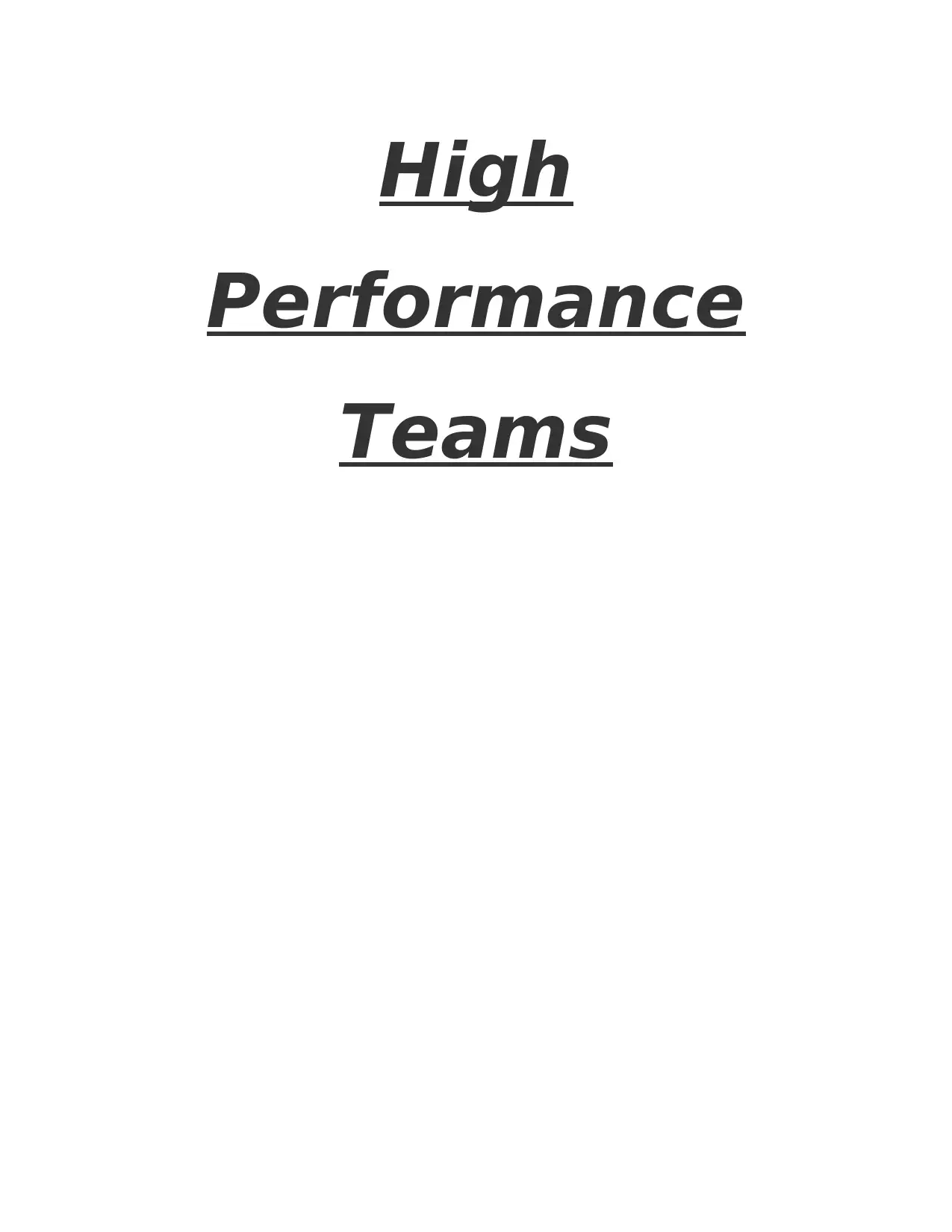
High
Performance
Teams
Performance
Teams
Paraphrase This Document
Need a fresh take? Get an instant paraphrase of this document with our AI Paraphraser
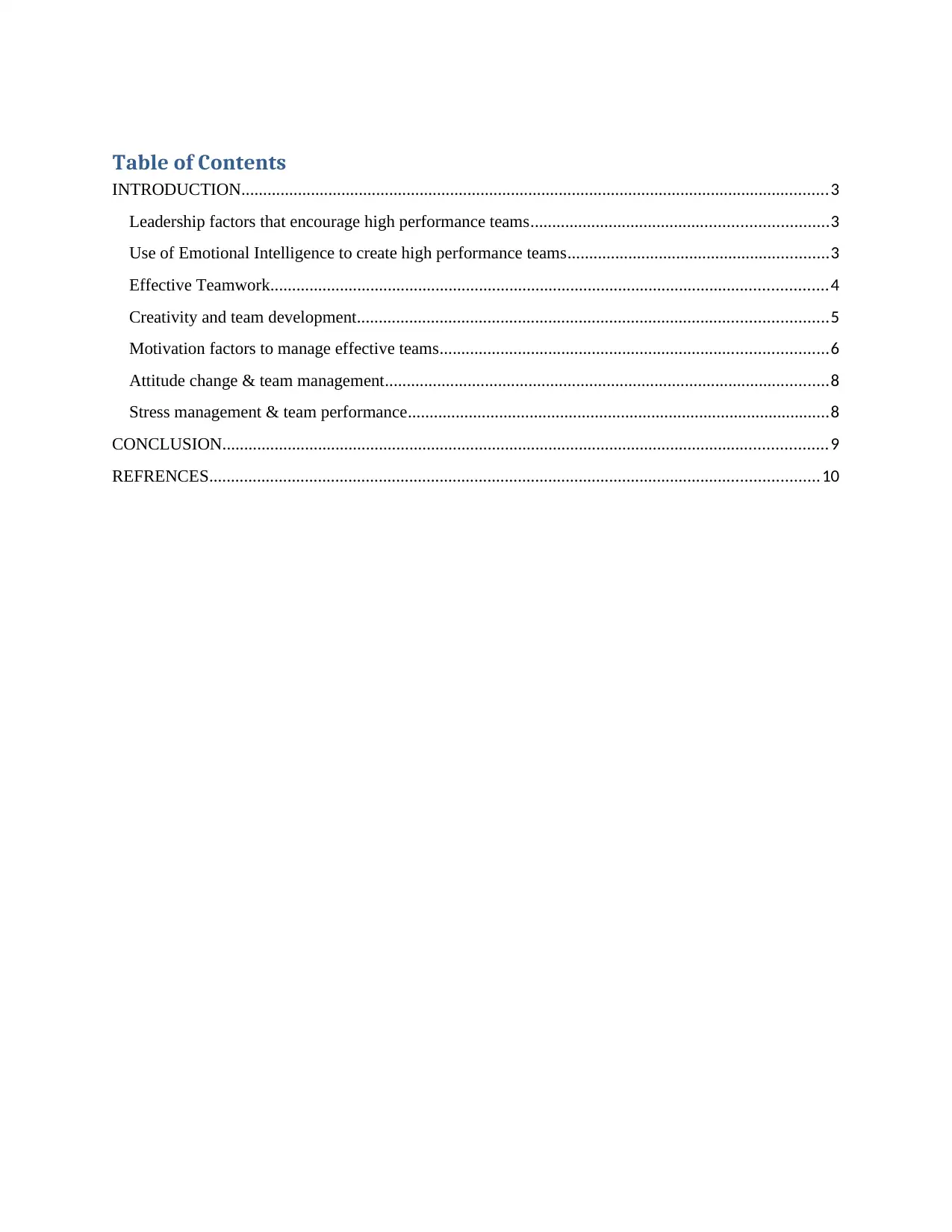
Table of Contents
INTRODUCTION.......................................................................................................................................3
Leadership factors that encourage high performance teams....................................................................3
Use of Emotional Intelligence to create high performance teams............................................................3
Effective Teamwork................................................................................................................................4
Creativity and team development............................................................................................................5
Motivation factors to manage effective teams.........................................................................................6
Attitude change & team management......................................................................................................8
Stress management & team performance.................................................................................................8
CONCLUSION...........................................................................................................................................9
REFRENCES............................................................................................................................................10
INTRODUCTION.......................................................................................................................................3
Leadership factors that encourage high performance teams....................................................................3
Use of Emotional Intelligence to create high performance teams............................................................3
Effective Teamwork................................................................................................................................4
Creativity and team development............................................................................................................5
Motivation factors to manage effective teams.........................................................................................6
Attitude change & team management......................................................................................................8
Stress management & team performance.................................................................................................8
CONCLUSION...........................................................................................................................................9
REFRENCES............................................................................................................................................10
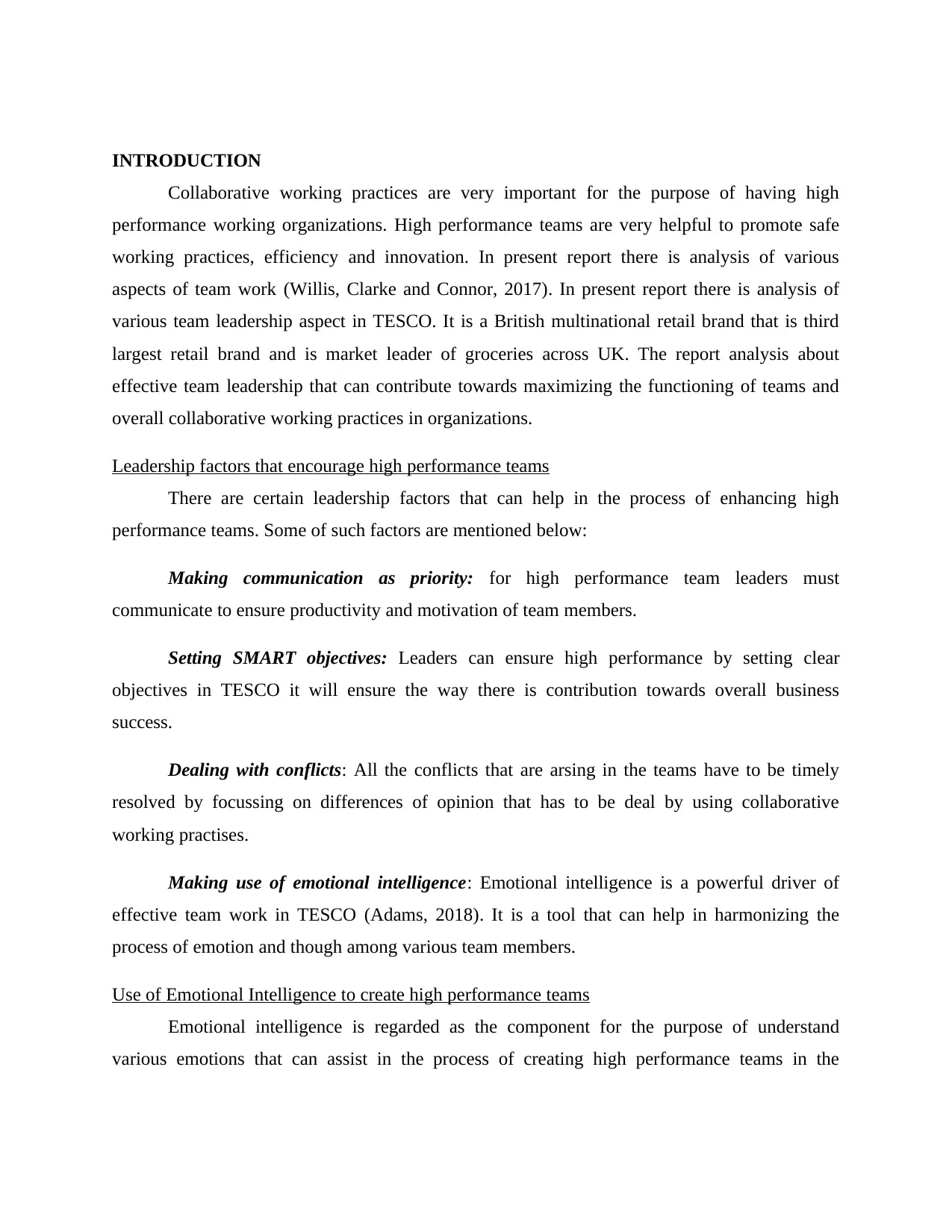
INTRODUCTION
Collaborative working practices are very important for the purpose of having high
performance working organizations. High performance teams are very helpful to promote safe
working practices, efficiency and innovation. In present report there is analysis of various
aspects of team work (Willis, Clarke and Connor, 2017). In present report there is analysis of
various team leadership aspect in TESCO. It is a British multinational retail brand that is third
largest retail brand and is market leader of groceries across UK. The report analysis about
effective team leadership that can contribute towards maximizing the functioning of teams and
overall collaborative working practices in organizations.
Leadership factors that encourage high performance teams
There are certain leadership factors that can help in the process of enhancing high
performance teams. Some of such factors are mentioned below:
Making communication as priority: for high performance team leaders must
communicate to ensure productivity and motivation of team members.
Setting SMART objectives: Leaders can ensure high performance by setting clear
objectives in TESCO it will ensure the way there is contribution towards overall business
success.
Dealing with conflicts: All the conflicts that are arsing in the teams have to be timely
resolved by focussing on differences of opinion that has to be deal by using collaborative
working practises.
Making use of emotional intelligence: Emotional intelligence is a powerful driver of
effective team work in TESCO (Adams, 2018). It is a tool that can help in harmonizing the
process of emotion and though among various team members.
Use of Emotional Intelligence to create high performance teams
Emotional intelligence is regarded as the component for the purpose of understand
various emotions that can assist in the process of creating high performance teams in the
Collaborative working practices are very important for the purpose of having high
performance working organizations. High performance teams are very helpful to promote safe
working practices, efficiency and innovation. In present report there is analysis of various
aspects of team work (Willis, Clarke and Connor, 2017). In present report there is analysis of
various team leadership aspect in TESCO. It is a British multinational retail brand that is third
largest retail brand and is market leader of groceries across UK. The report analysis about
effective team leadership that can contribute towards maximizing the functioning of teams and
overall collaborative working practices in organizations.
Leadership factors that encourage high performance teams
There are certain leadership factors that can help in the process of enhancing high
performance teams. Some of such factors are mentioned below:
Making communication as priority: for high performance team leaders must
communicate to ensure productivity and motivation of team members.
Setting SMART objectives: Leaders can ensure high performance by setting clear
objectives in TESCO it will ensure the way there is contribution towards overall business
success.
Dealing with conflicts: All the conflicts that are arsing in the teams have to be timely
resolved by focussing on differences of opinion that has to be deal by using collaborative
working practises.
Making use of emotional intelligence: Emotional intelligence is a powerful driver of
effective team work in TESCO (Adams, 2018). It is a tool that can help in harmonizing the
process of emotion and though among various team members.
Use of Emotional Intelligence to create high performance teams
Emotional intelligence is regarded as the component for the purpose of understand
various emotions that can assist in the process of creating high performance teams in the
⊘ This is a preview!⊘
Do you want full access?
Subscribe today to unlock all pages.

Trusted by 1+ million students worldwide
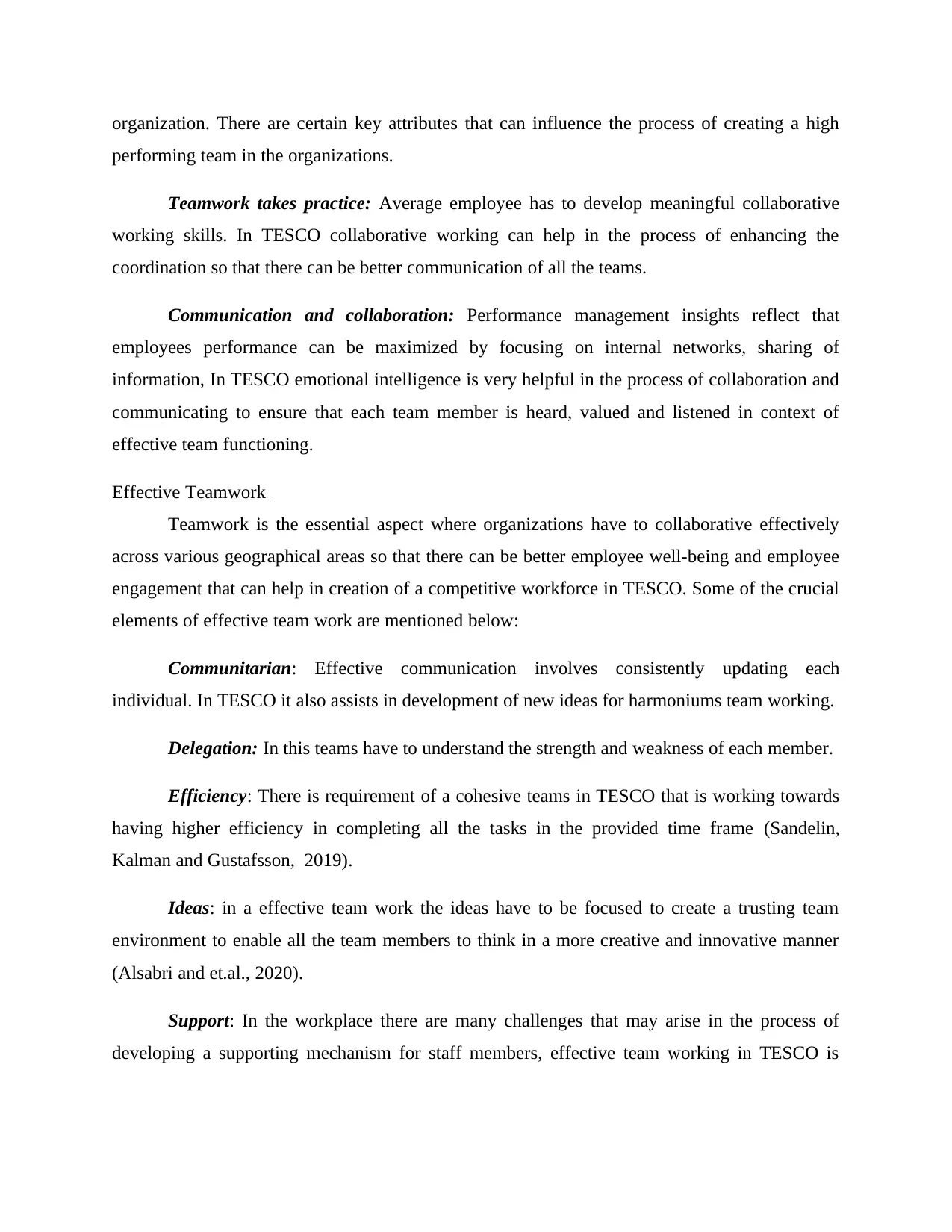
organization. There are certain key attributes that can influence the process of creating a high
performing team in the organizations.
Teamwork takes practice: Average employee has to develop meaningful collaborative
working skills. In TESCO collaborative working can help in the process of enhancing the
coordination so that there can be better communication of all the teams.
Communication and collaboration: Performance management insights reflect that
employees performance can be maximized by focusing on internal networks, sharing of
information, In TESCO emotional intelligence is very helpful in the process of collaboration and
communicating to ensure that each team member is heard, valued and listened in context of
effective team functioning.
Effective Teamwork
Teamwork is the essential aspect where organizations have to collaborative effectively
across various geographical areas so that there can be better employee well-being and employee
engagement that can help in creation of a competitive workforce in TESCO. Some of the crucial
elements of effective team work are mentioned below:
Communitarian: Effective communication involves consistently updating each
individual. In TESCO it also assists in development of new ideas for harmoniums team working.
Delegation: In this teams have to understand the strength and weakness of each member.
Efficiency: There is requirement of a cohesive teams in TESCO that is working towards
having higher efficiency in completing all the tasks in the provided time frame (Sandelin,
Kalman and Gustafsson, 2019).
Ideas: in a effective team work the ideas have to be focused to create a trusting team
environment to enable all the team members to think in a more creative and innovative manner
(Alsabri and et.al., 2020).
Support: In the workplace there are many challenges that may arise in the process of
developing a supporting mechanism for staff members, effective team working in TESCO is
performing team in the organizations.
Teamwork takes practice: Average employee has to develop meaningful collaborative
working skills. In TESCO collaborative working can help in the process of enhancing the
coordination so that there can be better communication of all the teams.
Communication and collaboration: Performance management insights reflect that
employees performance can be maximized by focusing on internal networks, sharing of
information, In TESCO emotional intelligence is very helpful in the process of collaboration and
communicating to ensure that each team member is heard, valued and listened in context of
effective team functioning.
Effective Teamwork
Teamwork is the essential aspect where organizations have to collaborative effectively
across various geographical areas so that there can be better employee well-being and employee
engagement that can help in creation of a competitive workforce in TESCO. Some of the crucial
elements of effective team work are mentioned below:
Communitarian: Effective communication involves consistently updating each
individual. In TESCO it also assists in development of new ideas for harmoniums team working.
Delegation: In this teams have to understand the strength and weakness of each member.
Efficiency: There is requirement of a cohesive teams in TESCO that is working towards
having higher efficiency in completing all the tasks in the provided time frame (Sandelin,
Kalman and Gustafsson, 2019).
Ideas: in a effective team work the ideas have to be focused to create a trusting team
environment to enable all the team members to think in a more creative and innovative manner
(Alsabri and et.al., 2020).
Support: In the workplace there are many challenges that may arise in the process of
developing a supporting mechanism for staff members, effective team working in TESCO is
Paraphrase This Document
Need a fresh take? Get an instant paraphrase of this document with our AI Paraphraser
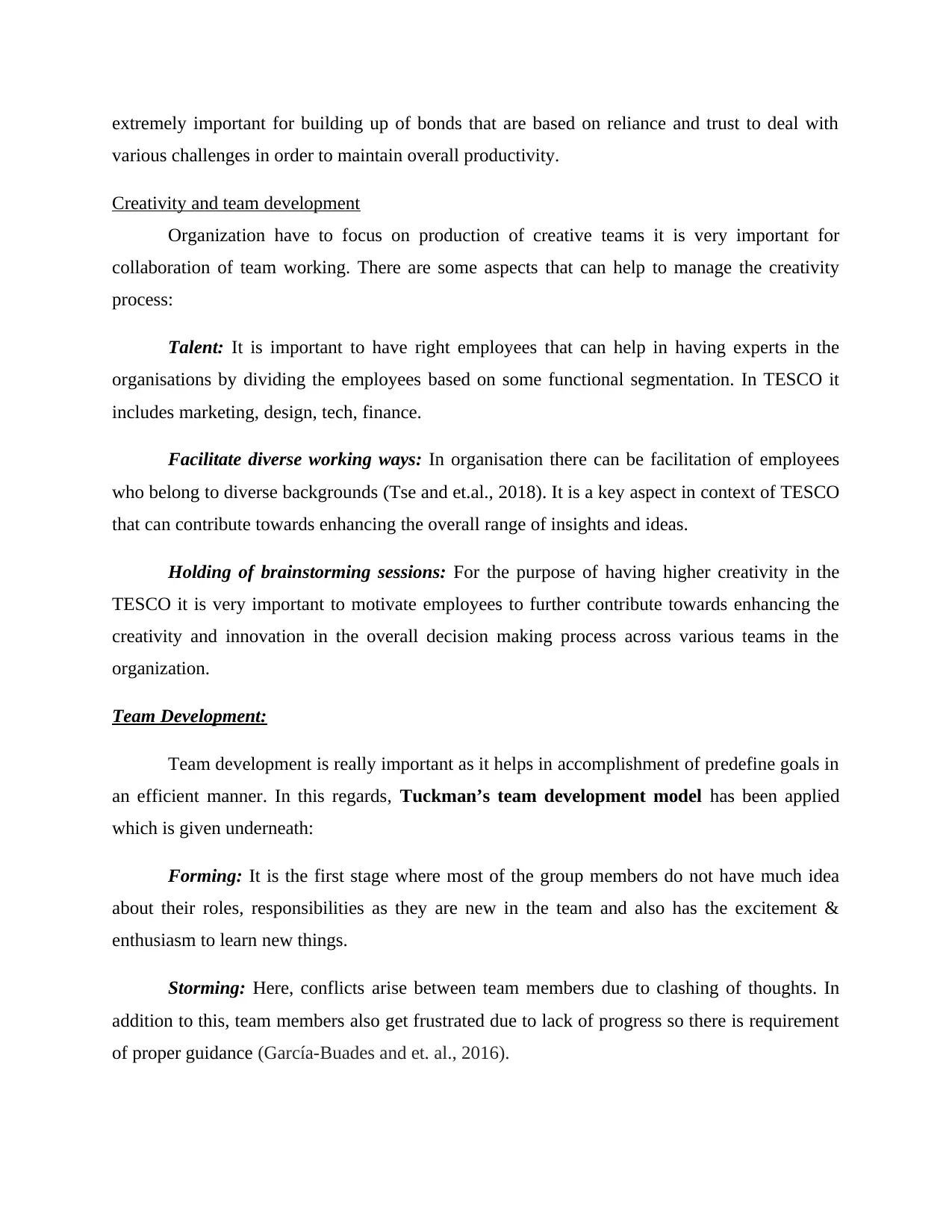
extremely important for building up of bonds that are based on reliance and trust to deal with
various challenges in order to maintain overall productivity.
Creativity and team development
Organization have to focus on production of creative teams it is very important for
collaboration of team working. There are some aspects that can help to manage the creativity
process:
Talent: It is important to have right employees that can help in having experts in the
organisations by dividing the employees based on some functional segmentation. In TESCO it
includes marketing, design, tech, finance.
Facilitate diverse working ways: In organisation there can be facilitation of employees
who belong to diverse backgrounds (Tse and et.al., 2018). It is a key aspect in context of TESCO
that can contribute towards enhancing the overall range of insights and ideas.
Holding of brainstorming sessions: For the purpose of having higher creativity in the
TESCO it is very important to motivate employees to further contribute towards enhancing the
creativity and innovation in the overall decision making process across various teams in the
organization.
Team Development:
Team development is really important as it helps in accomplishment of predefine goals in
an efficient manner. In this regards, Tuckman’s team development model has been applied
which is given underneath:
Forming: It is the first stage where most of the group members do not have much idea
about their roles, responsibilities as they are new in the team and also has the excitement &
enthusiasm to learn new things.
Storming: Here, conflicts arise between team members due to clashing of thoughts. In
addition to this, team members also get frustrated due to lack of progress so there is requirement
of proper guidance (García-Buades and et. al., 2016).
various challenges in order to maintain overall productivity.
Creativity and team development
Organization have to focus on production of creative teams it is very important for
collaboration of team working. There are some aspects that can help to manage the creativity
process:
Talent: It is important to have right employees that can help in having experts in the
organisations by dividing the employees based on some functional segmentation. In TESCO it
includes marketing, design, tech, finance.
Facilitate diverse working ways: In organisation there can be facilitation of employees
who belong to diverse backgrounds (Tse and et.al., 2018). It is a key aspect in context of TESCO
that can contribute towards enhancing the overall range of insights and ideas.
Holding of brainstorming sessions: For the purpose of having higher creativity in the
TESCO it is very important to motivate employees to further contribute towards enhancing the
creativity and innovation in the overall decision making process across various teams in the
organization.
Team Development:
Team development is really important as it helps in accomplishment of predefine goals in
an efficient manner. In this regards, Tuckman’s team development model has been applied
which is given underneath:
Forming: It is the first stage where most of the group members do not have much idea
about their roles, responsibilities as they are new in the team and also has the excitement &
enthusiasm to learn new things.
Storming: Here, conflicts arise between team members due to clashing of thoughts. In
addition to this, team members also get frustrated due to lack of progress so there is requirement
of proper guidance (García-Buades and et. al., 2016).
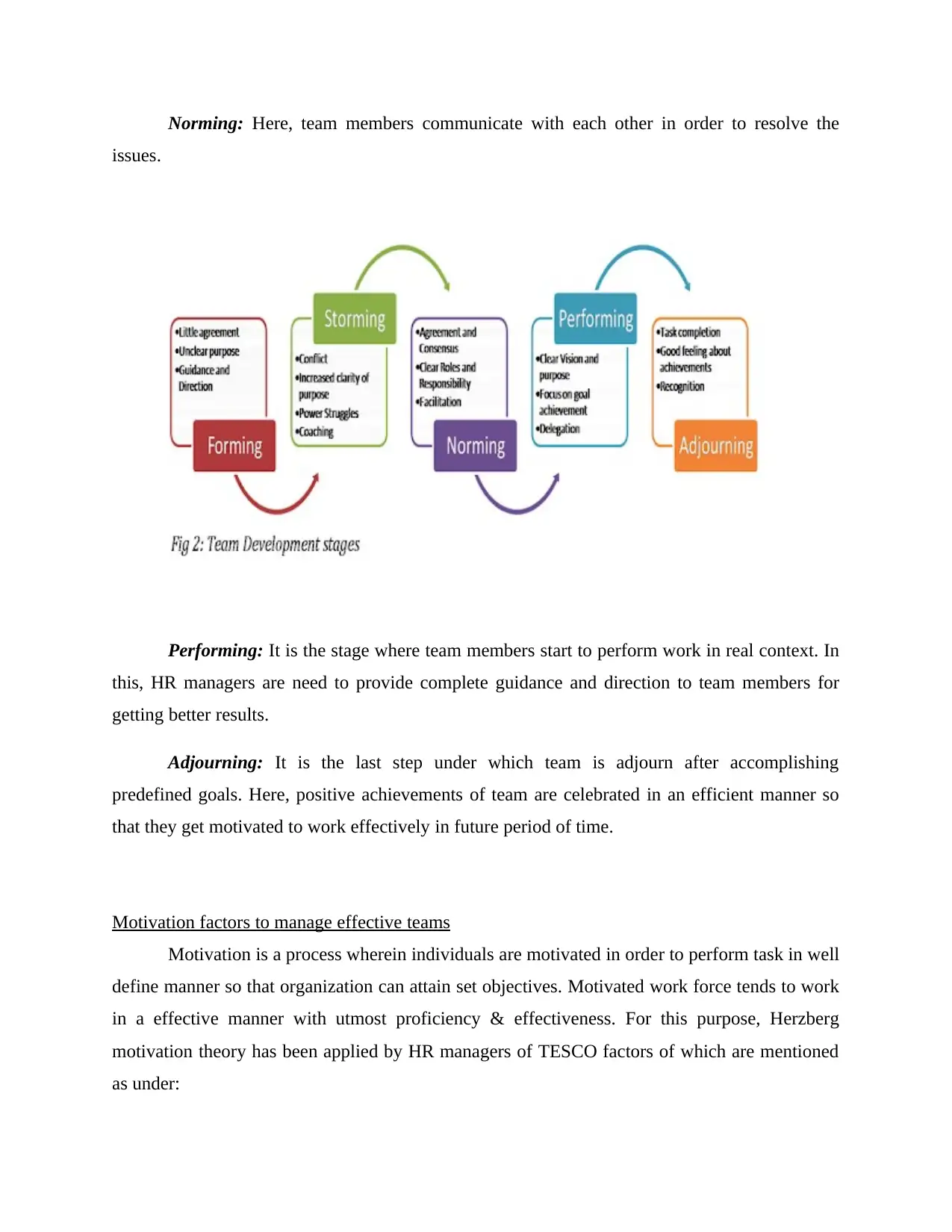
Norming: Here, team members communicate with each other in order to resolve the
issues.
Performing: It is the stage where team members start to perform work in real context. In
this, HR managers are need to provide complete guidance and direction to team members for
getting better results.
Adjourning: It is the last step under which team is adjourn after accomplishing
predefined goals. Here, positive achievements of team are celebrated in an efficient manner so
that they get motivated to work effectively in future period of time.
Motivation factors to manage effective teams
Motivation is a process wherein individuals are motivated in order to perform task in well
define manner so that organization can attain set objectives. Motivated work force tends to work
in a effective manner with utmost proficiency & effectiveness. For this purpose, Herzberg
motivation theory has been applied by HR managers of TESCO factors of which are mentioned
as under:
issues.
Performing: It is the stage where team members start to perform work in real context. In
this, HR managers are need to provide complete guidance and direction to team members for
getting better results.
Adjourning: It is the last step under which team is adjourn after accomplishing
predefined goals. Here, positive achievements of team are celebrated in an efficient manner so
that they get motivated to work effectively in future period of time.
Motivation factors to manage effective teams
Motivation is a process wherein individuals are motivated in order to perform task in well
define manner so that organization can attain set objectives. Motivated work force tends to work
in a effective manner with utmost proficiency & effectiveness. For this purpose, Herzberg
motivation theory has been applied by HR managers of TESCO factors of which are mentioned
as under:
⊘ This is a preview!⊘
Do you want full access?
Subscribe today to unlock all pages.

Trusted by 1+ million students worldwide
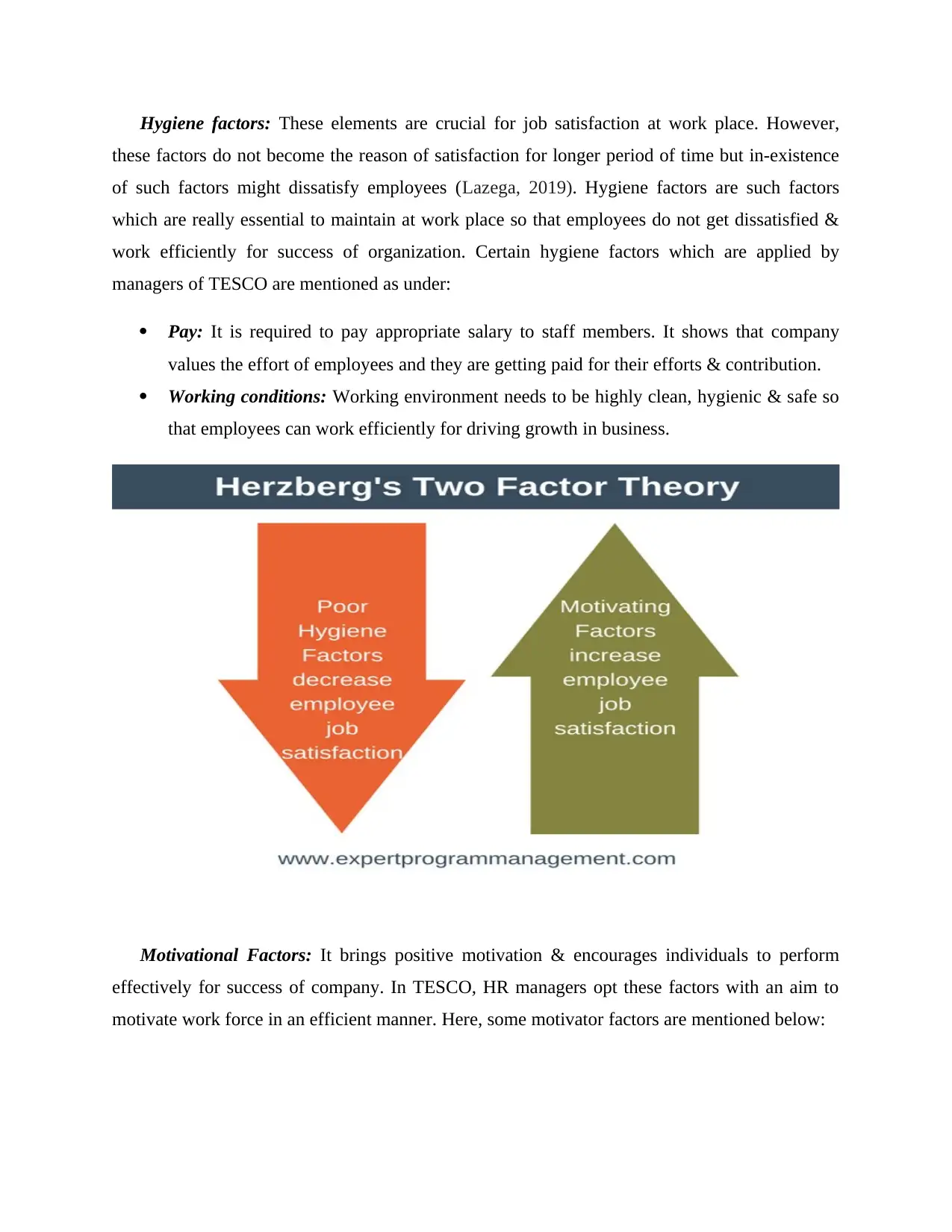
Hygiene factors: These elements are crucial for job satisfaction at work place. However,
these factors do not become the reason of satisfaction for longer period of time but in-existence
of such factors might dissatisfy employees (Lazega, 2019). Hygiene factors are such factors
which are really essential to maintain at work place so that employees do not get dissatisfied &
work efficiently for success of organization. Certain hygiene factors which are applied by
managers of TESCO are mentioned as under:
Pay: It is required to pay appropriate salary to staff members. It shows that company
values the effort of employees and they are getting paid for their efforts & contribution.
Working conditions: Working environment needs to be highly clean, hygienic & safe so
that employees can work efficiently for driving growth in business.
Motivational Factors: It brings positive motivation & encourages individuals to perform
effectively for success of company. In TESCO, HR managers opt these factors with an aim to
motivate work force in an efficient manner. Here, some motivator factors are mentioned below:
these factors do not become the reason of satisfaction for longer period of time but in-existence
of such factors might dissatisfy employees (Lazega, 2019). Hygiene factors are such factors
which are really essential to maintain at work place so that employees do not get dissatisfied &
work efficiently for success of organization. Certain hygiene factors which are applied by
managers of TESCO are mentioned as under:
Pay: It is required to pay appropriate salary to staff members. It shows that company
values the effort of employees and they are getting paid for their efforts & contribution.
Working conditions: Working environment needs to be highly clean, hygienic & safe so
that employees can work efficiently for driving growth in business.
Motivational Factors: It brings positive motivation & encourages individuals to perform
effectively for success of company. In TESCO, HR managers opt these factors with an aim to
motivate work force in an efficient manner. Here, some motivator factors are mentioned below:
Paraphrase This Document
Need a fresh take? Get an instant paraphrase of this document with our AI Paraphraser
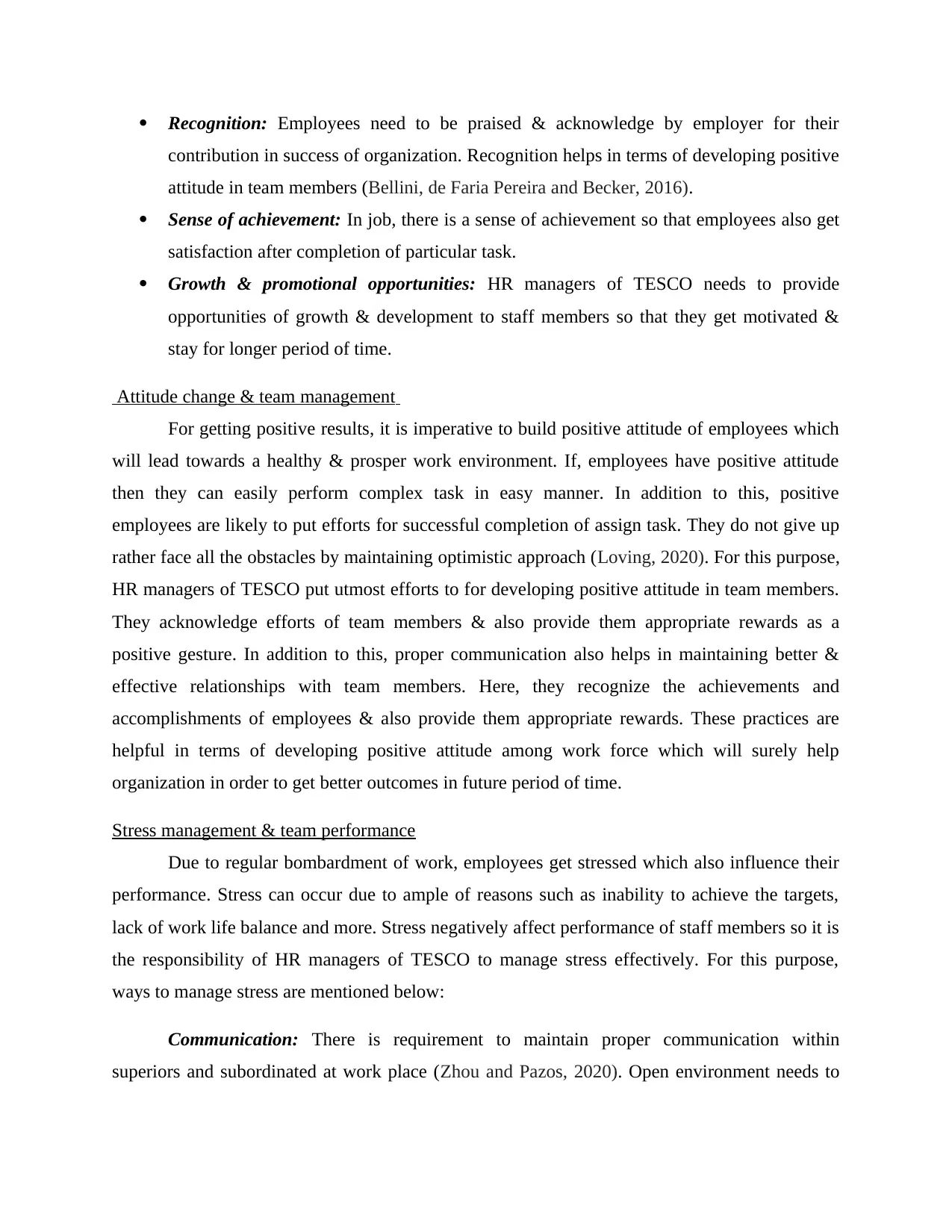
Recognition: Employees need to be praised & acknowledge by employer for their
contribution in success of organization. Recognition helps in terms of developing positive
attitude in team members (Bellini, de Faria Pereira and Becker, 2016).
Sense of achievement: In job, there is a sense of achievement so that employees also get
satisfaction after completion of particular task.
Growth & promotional opportunities: HR managers of TESCO needs to provide
opportunities of growth & development to staff members so that they get motivated &
stay for longer period of time.
Attitude change & team management
For getting positive results, it is imperative to build positive attitude of employees which
will lead towards a healthy & prosper work environment. If, employees have positive attitude
then they can easily perform complex task in easy manner. In addition to this, positive
employees are likely to put efforts for successful completion of assign task. They do not give up
rather face all the obstacles by maintaining optimistic approach (Loving, 2020). For this purpose,
HR managers of TESCO put utmost efforts to for developing positive attitude in team members.
They acknowledge efforts of team members & also provide them appropriate rewards as a
positive gesture. In addition to this, proper communication also helps in maintaining better &
effective relationships with team members. Here, they recognize the achievements and
accomplishments of employees & also provide them appropriate rewards. These practices are
helpful in terms of developing positive attitude among work force which will surely help
organization in order to get better outcomes in future period of time.
Stress management & team performance
Due to regular bombardment of work, employees get stressed which also influence their
performance. Stress can occur due to ample of reasons such as inability to achieve the targets,
lack of work life balance and more. Stress negatively affect performance of staff members so it is
the responsibility of HR managers of TESCO to manage stress effectively. For this purpose,
ways to manage stress are mentioned below:
Communication: There is requirement to maintain proper communication within
superiors and subordinated at work place (Zhou and Pazos, 2020). Open environment needs to
contribution in success of organization. Recognition helps in terms of developing positive
attitude in team members (Bellini, de Faria Pereira and Becker, 2016).
Sense of achievement: In job, there is a sense of achievement so that employees also get
satisfaction after completion of particular task.
Growth & promotional opportunities: HR managers of TESCO needs to provide
opportunities of growth & development to staff members so that they get motivated &
stay for longer period of time.
Attitude change & team management
For getting positive results, it is imperative to build positive attitude of employees which
will lead towards a healthy & prosper work environment. If, employees have positive attitude
then they can easily perform complex task in easy manner. In addition to this, positive
employees are likely to put efforts for successful completion of assign task. They do not give up
rather face all the obstacles by maintaining optimistic approach (Loving, 2020). For this purpose,
HR managers of TESCO put utmost efforts to for developing positive attitude in team members.
They acknowledge efforts of team members & also provide them appropriate rewards as a
positive gesture. In addition to this, proper communication also helps in maintaining better &
effective relationships with team members. Here, they recognize the achievements and
accomplishments of employees & also provide them appropriate rewards. These practices are
helpful in terms of developing positive attitude among work force which will surely help
organization in order to get better outcomes in future period of time.
Stress management & team performance
Due to regular bombardment of work, employees get stressed which also influence their
performance. Stress can occur due to ample of reasons such as inability to achieve the targets,
lack of work life balance and more. Stress negatively affect performance of staff members so it is
the responsibility of HR managers of TESCO to manage stress effectively. For this purpose,
ways to manage stress are mentioned below:
Communication: There is requirement to maintain proper communication within
superiors and subordinated at work place (Zhou and Pazos, 2020). Open environment needs to
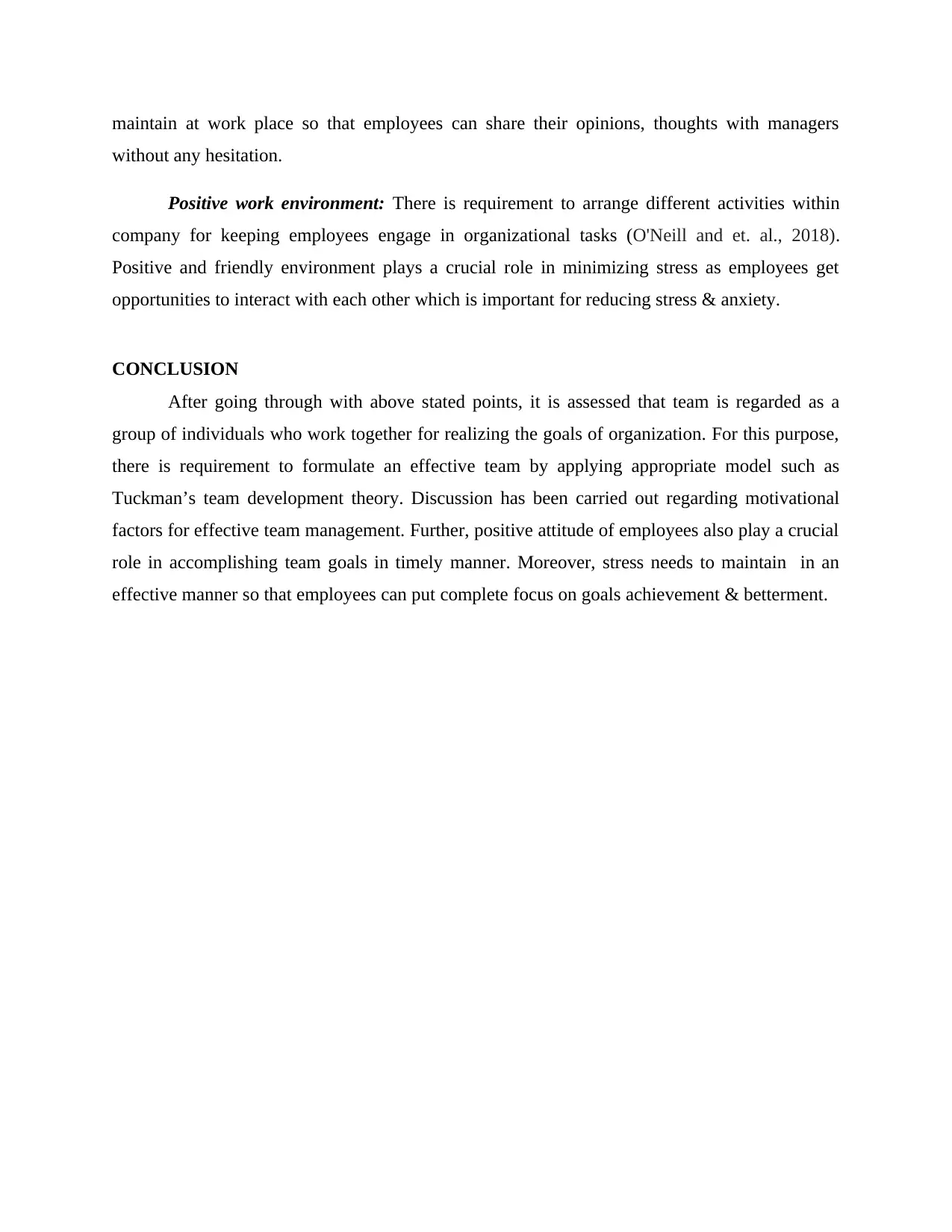
maintain at work place so that employees can share their opinions, thoughts with managers
without any hesitation.
Positive work environment: There is requirement to arrange different activities within
company for keeping employees engage in organizational tasks (O'Neill and et. al., 2018).
Positive and friendly environment plays a crucial role in minimizing stress as employees get
opportunities to interact with each other which is important for reducing stress & anxiety.
CONCLUSION
After going through with above stated points, it is assessed that team is regarded as a
group of individuals who work together for realizing the goals of organization. For this purpose,
there is requirement to formulate an effective team by applying appropriate model such as
Tuckman’s team development theory. Discussion has been carried out regarding motivational
factors for effective team management. Further, positive attitude of employees also play a crucial
role in accomplishing team goals in timely manner. Moreover, stress needs to maintain in an
effective manner so that employees can put complete focus on goals achievement & betterment.
without any hesitation.
Positive work environment: There is requirement to arrange different activities within
company for keeping employees engage in organizational tasks (O'Neill and et. al., 2018).
Positive and friendly environment plays a crucial role in minimizing stress as employees get
opportunities to interact with each other which is important for reducing stress & anxiety.
CONCLUSION
After going through with above stated points, it is assessed that team is regarded as a
group of individuals who work together for realizing the goals of organization. For this purpose,
there is requirement to formulate an effective team by applying appropriate model such as
Tuckman’s team development theory. Discussion has been carried out regarding motivational
factors for effective team management. Further, positive attitude of employees also play a crucial
role in accomplishing team goals in timely manner. Moreover, stress needs to maintain in an
effective manner so that employees can put complete focus on goals achievement & betterment.
⊘ This is a preview!⊘
Do you want full access?
Subscribe today to unlock all pages.

Trusted by 1+ million students worldwide
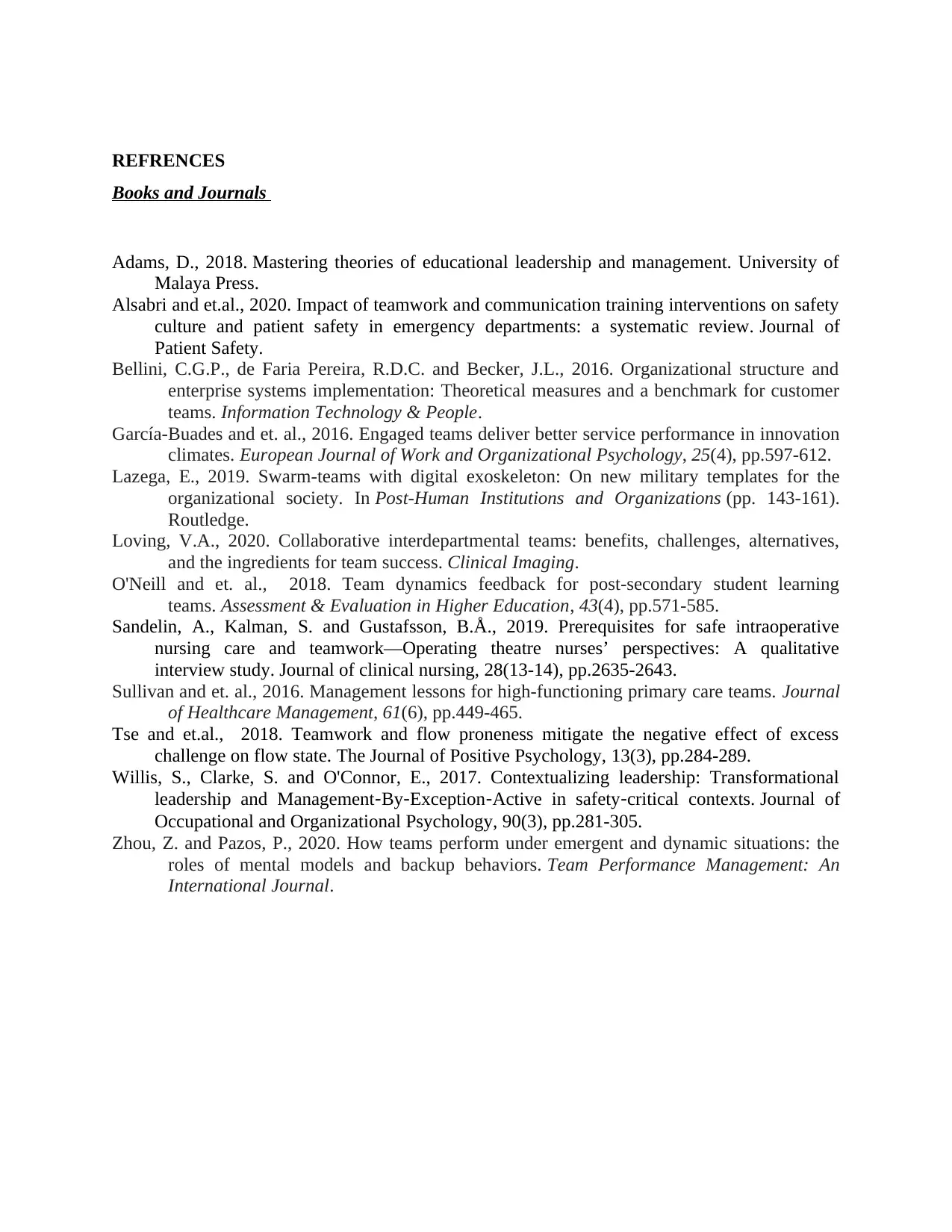
REFRENCES
Books and Journals
Adams, D., 2018. Mastering theories of educational leadership and management. University of
Malaya Press.
Alsabri and et.al., 2020. Impact of teamwork and communication training interventions on safety
culture and patient safety in emergency departments: a systematic review. Journal of
Patient Safety.
Bellini, C.G.P., de Faria Pereira, R.D.C. and Becker, J.L., 2016. Organizational structure and
enterprise systems implementation: Theoretical measures and a benchmark for customer
teams. Information Technology & People.
García-Buades and et. al., 2016. Engaged teams deliver better service performance in innovation
climates. European Journal of Work and Organizational Psychology, 25(4), pp.597-612.
Lazega, E., 2019. Swarm-teams with digital exoskeleton: On new military templates for the
organizational society. In Post-Human Institutions and Organizations (pp. 143-161).
Routledge.
Loving, V.A., 2020. Collaborative interdepartmental teams: benefits, challenges, alternatives,
and the ingredients for team success. Clinical Imaging.
O'Neill and et. al., 2018. Team dynamics feedback for post-secondary student learning
teams. Assessment & Evaluation in Higher Education, 43(4), pp.571-585.
Sandelin, A., Kalman, S. and Gustafsson, B.Å., 2019. Prerequisites for safe intraoperative
nursing care and teamwork—Operating theatre nurses’ perspectives: A qualitative
interview study. Journal of clinical nursing, 28(13-14), pp.2635-2643.
Sullivan and et. al., 2016. Management lessons for high-functioning primary care teams. Journal
of Healthcare Management, 61(6), pp.449-465.
Tse and et.al., 2018. Teamwork and flow proneness mitigate the negative effect of excess
challenge on flow state. The Journal of Positive Psychology, 13(3), pp.284-289.
Willis, S., Clarke, S. and O'Connor, E., 2017. Contextualizing leadership: Transformational
leadership and Management‐By‐Exception‐Active in safety‐critical contexts. Journal of
Occupational and Organizational Psychology, 90(3), pp.281-305.
Zhou, Z. and Pazos, P., 2020. How teams perform under emergent and dynamic situations: the
roles of mental models and backup behaviors. Team Performance Management: An
International Journal.
Books and Journals
Adams, D., 2018. Mastering theories of educational leadership and management. University of
Malaya Press.
Alsabri and et.al., 2020. Impact of teamwork and communication training interventions on safety
culture and patient safety in emergency departments: a systematic review. Journal of
Patient Safety.
Bellini, C.G.P., de Faria Pereira, R.D.C. and Becker, J.L., 2016. Organizational structure and
enterprise systems implementation: Theoretical measures and a benchmark for customer
teams. Information Technology & People.
García-Buades and et. al., 2016. Engaged teams deliver better service performance in innovation
climates. European Journal of Work and Organizational Psychology, 25(4), pp.597-612.
Lazega, E., 2019. Swarm-teams with digital exoskeleton: On new military templates for the
organizational society. In Post-Human Institutions and Organizations (pp. 143-161).
Routledge.
Loving, V.A., 2020. Collaborative interdepartmental teams: benefits, challenges, alternatives,
and the ingredients for team success. Clinical Imaging.
O'Neill and et. al., 2018. Team dynamics feedback for post-secondary student learning
teams. Assessment & Evaluation in Higher Education, 43(4), pp.571-585.
Sandelin, A., Kalman, S. and Gustafsson, B.Å., 2019. Prerequisites for safe intraoperative
nursing care and teamwork—Operating theatre nurses’ perspectives: A qualitative
interview study. Journal of clinical nursing, 28(13-14), pp.2635-2643.
Sullivan and et. al., 2016. Management lessons for high-functioning primary care teams. Journal
of Healthcare Management, 61(6), pp.449-465.
Tse and et.al., 2018. Teamwork and flow proneness mitigate the negative effect of excess
challenge on flow state. The Journal of Positive Psychology, 13(3), pp.284-289.
Willis, S., Clarke, S. and O'Connor, E., 2017. Contextualizing leadership: Transformational
leadership and Management‐By‐Exception‐Active in safety‐critical contexts. Journal of
Occupational and Organizational Psychology, 90(3), pp.281-305.
Zhou, Z. and Pazos, P., 2020. How teams perform under emergent and dynamic situations: the
roles of mental models and backup behaviors. Team Performance Management: An
International Journal.
1 out of 10
Related Documents
Your All-in-One AI-Powered Toolkit for Academic Success.
+13062052269
info@desklib.com
Available 24*7 on WhatsApp / Email
![[object Object]](/_next/static/media/star-bottom.7253800d.svg)
Unlock your academic potential
Copyright © 2020–2025 A2Z Services. All Rights Reserved. Developed and managed by ZUCOL.




